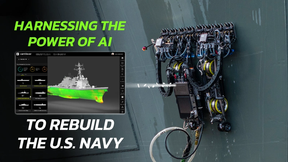The Government Made Me Do It
When I was a child, I spent a good part of my time getting into trouble, as most children do. My favorite excuse was “someone else made me do it.” Unfortunately, my father was not a big fan of that excuse and I cannot recall one incident that was overlooked based on this defense.
However, the Supreme Court of the United States has carved out such an excuse for equipment manufacturers that sell equipment or supplies to the United States military. This excuse is commonly referred to as the “Government Contractor Defense.” This exception is very important to ship builders and their suppliers because it can apply to both vessel manufacturers and the manufacturers of the equipment that is integrated into those vessels.
Because damages for injuries resulting from product liability actions can be very high, a company’s ability to position itself to take advantage of this defense could save your company, and your insurers, a significant amount of money. If your situation is ripe for relying on the defense, a little advance planning can make the utilization of the defense much easier.
In certain situations, a manufacturer of equipment or supplies will be exonerated from all state law-based claims, such as a product liability claim, if a simple test is met. As such, “the government made me do it” can be a valid defense for companies that contract with the various entities that comprise the Department of Defense. Essentially, if equipment that you manufacture is found to be the cause of an incident that caused either economic, property or personal damages, and you meet the requirements of this exemption, you can avoid all liability.
The United States Supreme Court in Boyle v. United Technologies Corporation enumerated the requirements of the Government Contractor Defense. The Court held that the Government Contractor Defense bars injured plaintiffs from asserting state-based product liability claims against defense contractors. The Court held that the federal government’s procurement of equipment involves a federal interest and state law-based tort claims such as a products liability claim would make it risky for defense contractors to provide products to the government because each state has a different set of laws that a manufacturer needs to comply with.
As mandated by the Supreme Court, the Boyle test states that defense contractors are exonerated from liability for state law-based design defects in military equipment when all of the following elements are met:
1. The United States approved reasonably precise specifications for the portion of the product at issue in the litigation
2. The equipment provided from the manufacturer to the government conformed to those specifications
3. The manufacturer warned the United States about dangers related to the use of the equipment that were known to the supplier but not to the United States
For firms that supply marine equipment to the Department of Defense, the first test, dealing with whether the United States approved reasonable and precise specifications, is usually the key element to avoiding liability under the Government Contractor Defense. To avail itself of this defense, the contractor will have to show that there was significant collaboration between the defense contractor and the government regarding the design of the equipment that was sold to the government. The courts have held that the government’s input must be meaningful and that a simple ratification of a pre-existing design concept does not constitute significant collaboration on the part of the government.
It is important to note that the government does not have to take responsibility for the design of the equipment; it only needs to participate in a substantial manner. With some advance planning, it is fairly easy to show that the government had meaningful involvement with the design process when the government’s participation in the overall design process is “deliberate and meaningful” as required by the courts. It is important to document this participation as the design approval process moves forward.
Another situation where this design involvement issue comes into play is when a company sells the same equipment to the military that it also provides to the general public. For example, a district court recently considered a case involving liability resulting from a distilling unit that was sold to both the United States Navy as well as other commercial users. Although the court found that the products supplied to the Navy and other commercial users were substantially similar, they did find that the Navy exercised “direct and detailed control” over the manufacturer’s ability to place warnings on the marine distilling units. Because the case hinged on the lack of warnings supplied by the manufacturer, and the Navy exercised control over that design component, the contractor was able to avail itself of the Government Contractor Defense and was dismissed from the case.
Thus, the military does not have to exercise control over the design of the entire piece of equipment. If the design issue is related to the injury at hand, showing that the government was involved in the design, or ratification of the design, of a small component of a much larger piece of equipment, then it is enough to protect you with the Government Contractor Defense.
The second element of the test requires that the product provided by the manufacturer meets the design criteria as outlined by the military. This element is fairly straightforward and self-explanatory. If you provide equipment to the military that does not comply with the specifications, you open yourself up to liability from both an injured plaintiff and the federal government for supplying improper equipment.
The final Boyle element requires that the contractor warn the government about possible dangers regarding the use of the product that are known to the contractor but not the government. The defense contractor must provide evidence that it did not have any knowledge of the alleged defect or that the government was already aware of such a defect. Proving this final element is usually made easier by the large amount of paperwork and data that is exchanged with the government during the equipment procurement process. Usually, any defects that are known to the manufacturer are disclosed through the specification, design and performance approval processes.
Although the Government Contractor Defense provides a limited shield of liability for equipment manufacturers, it is a very important area of the law for companies that manufacturer equipment that is sold to the Department of Defense. As everyone in the industry is aware, the military tends to purchase equipment that is used under harsh circumstances and by users of a wide range of abilities. As such, the prospect of a potential product liability claim is much higher in this setting than it would be in a normal commercial transaction.
Essentially, vessel builders and their component equipment manufacturers can save a significant amount of money in the event of a product liability claim if they can show that the government was involved in the design process. Even if the government was not involved in the original design process, get them involved in understanding and ratifying your design before the order is placed. Although the government’s involvement may seem like a hassle on the front end, it could save you millions of dollars on the back end.
Lawrence R. DeMarcay, III is a partner at Fowler Rodriguez Valdes-Fauli in the firm’s New Orleans, Louisiana office. He can be reached at 504.595.5122 or [email protected].
(reprinted from MarineNews May 2009)













